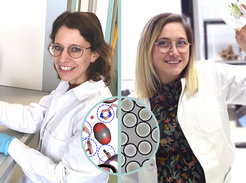Double success for young scientists
Iria Grundling receives the VAAM PhDAward, Tarryn Miller wins the MarBiNa Award.

Tarryn Miller received the MarBiNa Award 2020 for her research on synthetic photosynthesis which led to the development of a synthetic chloroplast.
Iria Grundling (formerly Berhardsgrütter) worked as a doctoral student of Tobias Erb on the understanding and engineering of CO2-fixing enzymes. She focused on an enzyme nanoreactor called propionyl-CoA synthase and managed to increase the CO2-fixing capacity of the enzyme from below five to above 90% by selectively exchanging amino acids. The optimization could also be applied to other enzymes in the future and open up new ways of converting CO2.
Tarryn Miller, also a doctoral student in Tobias Erb´s research group, developed of a platform that allows photosynthesis to be carried out in tiny droplets. Independently of this, this allows to also investigate other issues in synthetic metabolism research. One very important field of application in the future could be the binding of carbon dioxide in order to produce substances faster, cheaper and more environmentally friendly.
Iria and Tarryn, Congratulations! You have both been awarded for your work in the field of CO2 conversion, but you were investigating different aspects. What intrigues you most about your field of research, and what was perhaps the most surprising element?
Iria: For me, it was and will always be surprising how tiny changes in an enzyme can impact its function. In the protein I have been studying, the propionyl-CoA synthase, the CO2-binding pocket was perfectly conserved but we could barely detect any carboxylated product. We realized that one of the CO2-binding residues was locked in a wrong orientation and freeing it from that position by one amino acid change markedly improved the CO2-fixing efficiency of PCS. I was happy enough to play a role in the uncovering of one of Nature`s sophisticated mechanisms - Nature has so many tricks to produce efficient and highly complex biocatalysts and I am sure that we are just scratching on the surface of what still remains uncovered.
Tarryn: I am surprised that we can mimic complex cellular processes of life in vitro. We can rebuild a model of photosynthesis by combining thylacoids from chloroplasts with the synthetic CETCH cycle. The thylacoids serve as the energy module, using light energy to drive the biochemical reactions.
I am fascinated by the boundless possibilities of the life on this planet. Evolution has had specific boundary conditions, but of all life forms, bacteria in particular have found creative solutions to exploit every niche. I am hopeful that scientists can tackle the world`s most pressing problems by learning from organisms and mimicking nature`s solutions within the lab.
What what was the most influential thing in your time as doctoral students?
Tarryn: I especially appreciated that I was continually interacting with very intelligent people from around the world, they continued to challenge me and help me improve my work and scientific understanding. This was a very enriching place to do research and I could not have done this without my wonderful colleagues and supervisor.
Iria: There is a very collaborative atmosphere at the MPI and I appreciated the great work of the core facilities. There is much in-house technology and know-how, which clearly pushes the quality of the science.
What hopes and wishes do you have for the future?
Iria: I wish that one day, the synthetic CO2-fixation pathways that are designed and established in the Erb lab will find an application in biotechnology in order to reduce the emission of CO2 into the atmosphere. And of course, I would be super proud if the enzymes I´ve studied would be part of such a pathway.
Tarryn: I agree with what Iria said. I wish that one day, I can see our work translated into useful, even lifesaving applications. As a young female scientist I am passionate about making a difference in this world. I love learning new things and doing cutting edge science. I want to continue doing this wherever I go next.
Thank you, and best wishes!
The Association for General and Applied Microbiology (VAAM) brings together about 3500 microbiology-oriented scientists. The VAAM Research Award is presented annually at the VAAM Annual Meeting to a young scientist for outstanding recent work in the field of microbiology.
The Initiative for Bio- and Nanotechnology e.V., (IBiNa), which was founded in 2007, promotes young scientists in the field of biotechnology and nanotechnology and awards them for their outstanding work. The Promotion Prize will also be offered in 2021. This year, for the first time, self-applications are permitted. More Information ca be found here.












